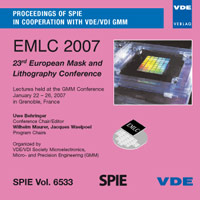Electron beam directed repair of fused silica imprint templates
Konferenz: EMLC 2007 - 23rd European Mask and Lithography Conference
22.01.2007 - 26.01.2007 in Grenoble, France
Tagungsband: EMLC 2007
Seiten: 6Sprache: EnglischTyp: PDF
Persönliche VDE-Mitglieder erhalten auf diesen Artikel 10% Rabatt
Autoren:
Schmid, Gerard M.; Resnick, Douglas J. (Molecular Imprints, Inc., Austin, Texas, 78758 USA)
Fettig, Rainer; Edinger, Klaus (Carl Zeiss SMS GmbH, 64380 Rossdorf, Germany)
Young, Steven R.; Dauksher, William J. (Motorola Labs, Tempe, Arizona, 85284 USA)
Inhalt:
Imprint lithography has been shown to be an effective method for replication of nanometer-scale structures from a template mold. Step-and-Flash Imprint Lithography (S-FIL(TM)) employs a UV-photocurable imprint liquid, which enables imprint processing at ambient temperature and pressure. The use of a transparent fused silica template facilitates precise overlay. With this combination of capabilities, NIL is a multi-node technique that is suitable for advanced prototyping of processes and devices to meet the anticipated needs of the semiconductor industry. However, since the technology is 1X, it is critical to address the infrastructure associated with the fabrication of templates. An essential part of this infrastructure is the capability to identify and repair template defects. Fused silica imprint templates are typically produced from photomask substrates, and it is straightforward to make use of the tools and processes that have been developed to repair commercial photomasks. However, the optical properties of the repaired region are of secondary importance because S-FIL patterning is based on direct transfer of topography (rather than indirect transfer of an optical image). As in conventional photolithography, both additive and subtractive repairs are required to correct a variety of defect types. Repair techniques that are based on electron-beam induced chemical reactions have demonstrated the capability to perform both additive (deposition) and subtractive (etching) processes at high resolution. This work is a demonstration that electron-beam directed additive repair is capable of repairing fused silica template structures with sub-100 nm resolution.


